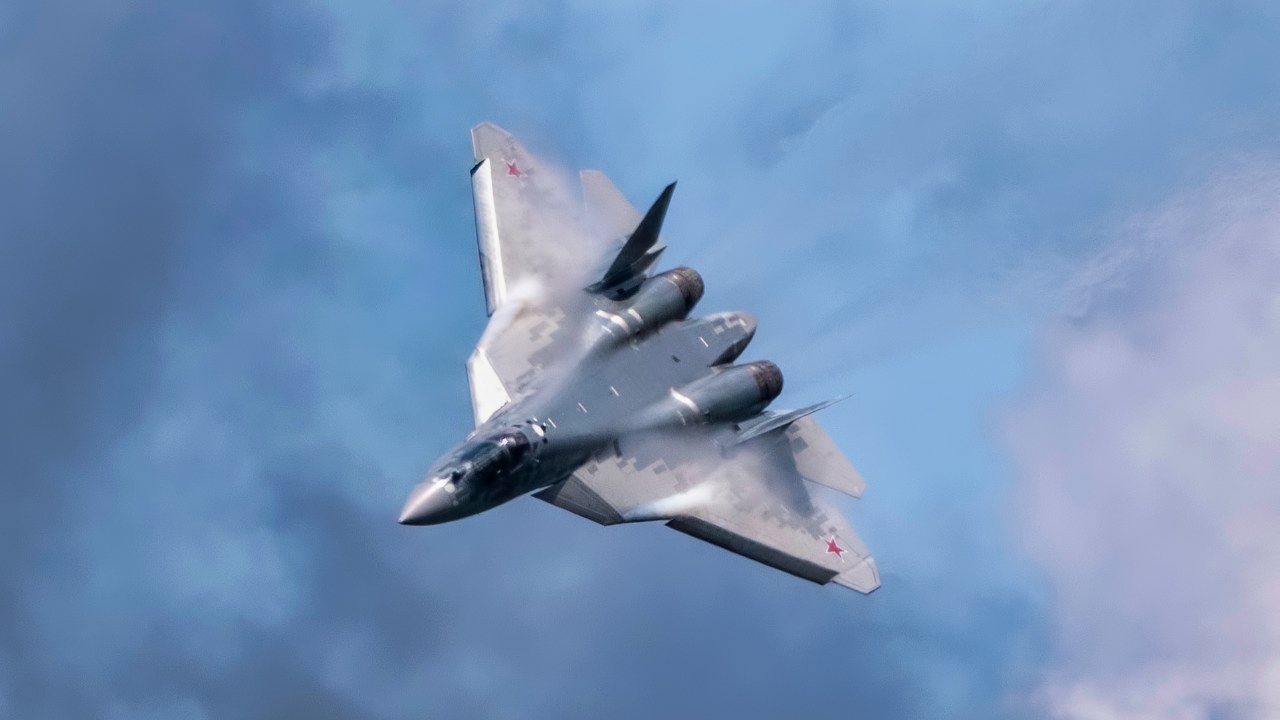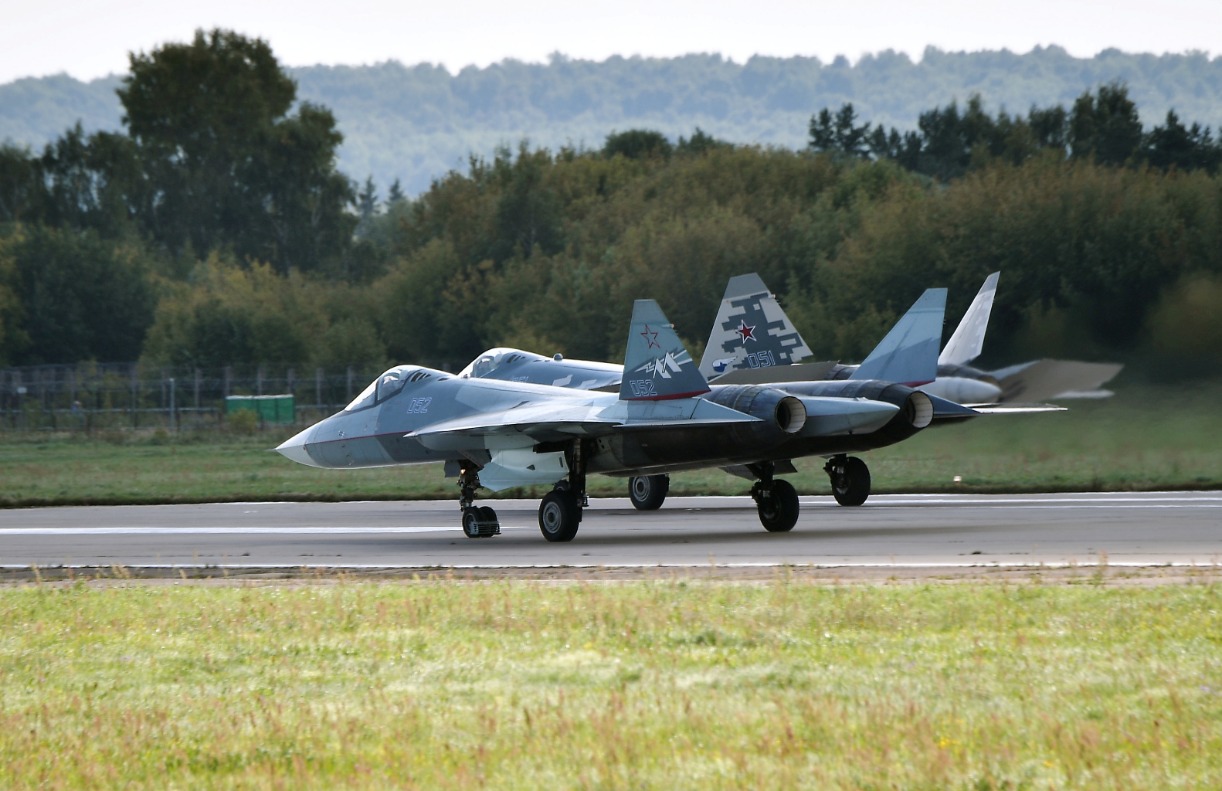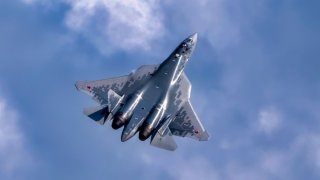Russia's Su-57 Stealth Fighter May Now Have a 'Fatal Flaw'
According to reports from Ukrainian intelligence sources, the production of Russia’s Su-57, its premier fifth-generation fighter, may have been suspended due to the impact of Western sanctions.
What You Need to Know: The production of Russia’s Su-57, its premier fifth-generation fighter, may have been suspended due to the impact of Western sanctions, according to reports from Ukrainian intelligence sources.

-The Su-57 program has been hampered by reliance on Western-made components, which have become inaccessible following the sanctions imposed after Russia’s invasion of Ukraine. Though Russia has built a degree of self-sufficiency and has managed to maintain many military programs despite sanctions, the Su-57 remains vulnerable to the tech embargo.
-While the suspension may deal a blow to Russia's aerospace industry, the Kremlin’s reliance on older Soviet-era warplanes has proven effective in Ukraine. The Su-57’s limited role in the ongoing conflict suggests its suspension will not significantly alter the course of the war.
Russia Suspends Su-57 Production Line?
The Su-57 is Russia’s premier fifth-generation warplane. It is without a doubt the country’s crowning achievement in terms of aerospace warfighters. Yet, there are unconfirmed reports coming from Ukrainian analysts at the private intelligence group, Frontintelligence Insight, indicating that the Russians may have finally suspended the production line of the Su-57 due to a lack of access to advanced Western components (which have been sanctioned by the United States and their allies since the start of the war).
When the Russians brutally invaded neighboring Ukraine, the Americans and their NATO partners went on a sanction spree, hoping to both punish Russia for breaking the peace (as they saw it) and to prevent advanced Western components from reaching Russia (where the Russians will integrate those components into weapons bound for Ukraine).
Russia is Incredibly Self-Sufficient
The sanctions regime, for the most part, has only been effective in forcing the Russians—already a relatively self-sufficient economy, thanks to their massive commodities wealth—to almost completely detach itself from reliance upon the West.
This pattern has played out in just about every industry that Russia operates in, notably the energy sector, where nations like India and China have more than happily received Russian natural gas and oil supplies originally bound for Europe. Because of these moves, the Russian war machine has sustained itself in spite of the sanctions and pressures the West have put on them. But the Russians have still struggled.
After all, the Russians, no matter how self-sufficient they’ve become, are still living on Planet Earth where international trade is essential—and where (for now) Washington sits at the center of that international trading network.
So, Russian designs can be complicated by the American sanctions.
Although, Russia has not yet been defeated by those sanctions—regardless of how much Washington, Brussels, and London tut-tut about the power of those economic sanctions. Indeed, the Russians have managed to create an alternative, Eurasian-wide supply chain for their war effort that is clearly keeping pace with the obviously beleaguered Western defense industrial base.

There are a few areas, though, where the Western sanctions have had devastating effects. This brings us back to the Su-57. While this plane is undoubtedly the most powerful and advanced warplane in the Russians’ arsenal, the fact that the Sukhoi Design Bureau made the Su-57 heavily dependent on Western components to function means that the Su-57 program is highly susceptible to Western sanctions.
Russia: Hoist by Its Own Problems
The reason that Moscow made this platform so reliant upon Western technology is primarily because Russia wanted the Su-57 to be their newest export. By making the bird compatible with many Western technological components, Russia rightly assumed that it’d make the Su-57 a competitive product on the global arms market.
Many nations purchasing the Su-57 from Russia would be enticed, at least in theory, by the Su-57’s interoperability with Western technologies that many of the potential purchasers of the product possess.
It’d have not been an onerous affair for foreign buyers to procure the Su-57 because they’d likely not have to purchase subsequent support technologies from Russia, they could simply use the Western systems they already had. Moscow’s decision to employ Western technologies in the design of the Su-57 was a double-edged sword.
Yes, it would have made the Su-57 a competitive export on the global arms market. But Moscow’s decision to invade Ukraine in 2022 prompted the West to sanction Russia. Alas, the Su-57 is now in technical pickle.
Plus, the Su-57 encountered yet another downside since the Russian war in Ukraine began. Because the technological components have been restricted to Russia, the Russians are having difficulty producing the advanced Su-57 in reliable numbers (because of the tech bans).
There was some talk about the Russians attempting to circumvent the Western tech bans by going through third-party states but given Russia’s all-hands-on-deck approach to the War in Ukraine, the Kremlin has likely concluded that it’s not worth the precious resources to jump through the hoops they’d need to for acquiring these Western tech components.
Russia Doesn’t Need the Su-57 to Win…
The Russians have been reticent to send these birds into the chaos pit that is the Ukraine War for fear of losing too many of these irreplaceable planes. It’s a sensible choice, especially since older, cheaper Soviet era warplanes have been very effective for Russia against Ukraine.
The problem for Russia is that, by holding these systems in reserve, away from their existential war against Ukraine, potential foreign buyers believe that the planes may not perform as expected.
Beyond that, if the production line is not humming for these birds, and if the West is simply going to sanction Sukhoi’s premier product, there’s little incentive for Russia to continue building these until the war is over and the sanctions are lifted.
Westerners looking for glimmers of hope in the Ukraine War are clinging to this possible news that the Su-57 is being suspended as though it’s indicative of some greater crisis afflicting Russia.
Sadly for the Ukrainians, the Russians are not abating in their war against Kiev. Ukrainian forces have struggled under the weight of Russia’ gruesome war of attrition, which is draining Ukrainian coffers and filling Ukrainian coffins full of young Ukrainians at a far greater rate than Kiev can possibly hope to replace—or to sustain in the long-run.
The Su-57 is a cool plane. It’s not a decisive factor in Russia’s war, though. It’s a war of metal and meat—and the Russians, unfortunately, have more of that to spare than do the Ukrainians.
Author Experience and Expertise: Brandon J. Weichert
Brandon J. Weichert, a National Interest national security analyst, is a former Congressional staffer and geopolitical analyst who is a contributor at The Washington Times, the Asia Times, and The-Pipeline. He is the author of Winning Space: How America Remains a Superpower, Biohacked: China’s Race to Control Life, and The Shadow War: Iran’s Quest for Supremacy. His next book, A Disaster of Our Own Making: How the West Lost Ukraine, is due October 22 from Encounter Books. Weichert can be followed via Twitter @WeTheBrandon.
All images are Creative Commons or Shutterstock.
From the Vault
Russia Freaked Out: Why the U.S. Navy 'Unretired' the Iowa-Class Battleships
Battleship vs. Battlecruiser: Iowa-Class vs. Russia's Kirov-Class (Who Wins?)


